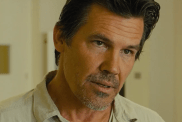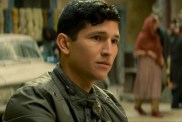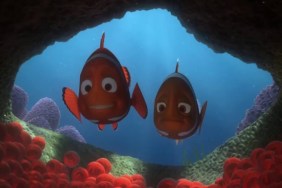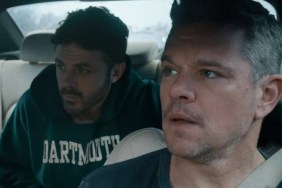The X-Files director on his new ’50s alien invasion flick

The resurgence of interest in alien invasion and monster movies of the ’50s and ’60s has reached a feverish pitch in recent years, from the remakes of War of the Worlds and The Day the Earth Stood Still to DreamWorks Animation’s latest movie Monsters vs. Aliens, which pays homage to all the greats.
It was only time before someone decided to go back in time and recapture the look and feel of the original movies and the man for that job was R.W. Goodwin, long-time director of Chris Carter’s “The X-Files”, who teamed with writers James Swift and Steven Fisher to create Alien Trespass, a bonafide ’50s alien invasion movie that goes as far as humanly possible to recreate all the quirks and nuances that made some of those old movies as scary as they were inadvertently funny.
It stars Eric McCormack as small-town astronomer Ted Lewis who gets caught up in an alien invasion by the deadly and monstrous Ghota, a tentacled one-eyed creature that can only be stopped by the mysterious alien named Urp (also played by McCormack) with the help of local waitress Tammy, played by Jenni Baird in her feature film debut.
ShockTillYouDrop.com had a chance to sit down with Goodwin when he came to New York to present footage from the movie at New York Comic-Con.
ShockTillYouDrop.com: Now was this an idea you were tossing around for a long time that you’ve always wanted to do?
R.W. Goodwin: Jim Swift is my producing partner and actually, it was really his idea. He’d been working on it for three years or so before I met him, and we live in a small city up in Northwest Washington, but we quickly found out that we’d both gone to the elementary school and junior high school in L.A. at the same time. He’s a year or two younger than me, so I didn’t pay any attention to him. We were both fans of the ’50s movies, we saw them when we were younger kids but he was also an “X-Files” fan. He had the story idea that he kind of fleshed out with the writer Steven Fisher and then he had three scripts, one by Steve and two by someone else, and was just frustrated by it, and asked if I’d take a look at it and get involved. I just loved the story. I thought it was the greatest idea because the concept of it I liked was that I liked the old ’60s sci-fi moviesâand he took three of the best, “War of the Worlds”, “The Day the Earth Stood Still” and “It Came From Outer Space”, which were all classicsâand he kind of squished the stories together. I used to like the when I was a young kid, and of course, I watched them on TV coming up just like everybody else and was a fan of them, but when I went and looked at some of them when he asked me to get involved. Looking at them now, 50 years later⦠at the time they made them, they were really serious about it, the filmmakers. They were really earnest, the actors, the directors, they were intent on making a great sci-fi movie, but they were working in ’50s styles and techniques and so much has changed in 50 years that when you look at them now, 50 years later, they are inadvertently funny. I thought if we could make one like that and really stick to our guns and stay with the style of the times and not try to do a parody or a spoof, that we could make a movie that’s intentionally, inadvertently funny.
Shock: I was wondering about that because the movie is played very seriously, but it still seems very funny at times.
Goodwin: No, and I think it kind of worked. We never intended this to be some sort of laugh-fest, “Airplane!” kind of movie, that’s not the idea. We wanted it to really capture a time, which it does I think, which is charming and more innocent and more hopeful. Life was simpler. It’s something a lot of us, especially with what’s going on in the world today, it’s kind of a great place to escape to, to go back to a time when life was easier, the only thing we really worried about was nuclear holocaust. But other than that, everything was fine! (chuckles) What we were looking to do was a movie that was funny and more than anything fun, and then have some moments that do scare you. There’s some actual scares in the movie, and also, in the ’50s they’d take a bit more time to develop characters that you cared about and I think that’s part of what happens, too. If you get more invested in the characters, you involve yourself more in the story. That’s what we’ve been finding. Most audiences get real involved. They laugh and have fun a lot, but also, the most important thing, is that they’re kind of transported into a different world and time.

Shock: What’s interesting is that in the last ten years, interest in those movies has come back for better or worse because of the remakes of those movies. It seems like there’s some kind of mindset that now’s a good time to revisit those great old sci-fi movies.
Goodwin: I think it is. I’ve always been allergic to remakes. The only remakes I think worked are remakes of pictures that didn’t work the first time or pictures that you take so many years that there’s no memory of them. One of the ones I think about was that great movie that Judy Garland did, “A Star Is Born.” That was done back in the ’30s I think but no one remembered it, but when you take something like “War of the Worlds” or “Psycho” or something that’s just so much of a slam dunk piece in itself, I think it’s a real danger to try to remake it. That was what was more compelling about this for me, because we were able to make a ’50s movie and really have fun adhering to all the styles and techniques, but we weren’t copying any other script, it was an original. If you look at some of the techniques I used, I had more fun. I don’t know if you noticed it, but you know the scene where she blows out the two candles? If you take a look at that, she leans over and she blows out the candle… and then the light changes. She blows out the other candle⦠and then the light changes. If you look at “It Came from Outer Space” in the first scene, Barbara Rush blows out a candle and it seems like 8 seconds before the guy hits the light switch. So stuff like that. When he’s walking alongside her and she pulls up in the truck, he’s walking on a treadmill but if you look real carefully, when he stops to talk to her, the background keeps moving. That was because they didn’t have the technology to do it any better.
Shock: Did you actually go back and study the movies to see exactly how they did some of those things?
Goodwin: Oh, we’ve studied all kinds of things, everybody: Actors, production people, and myself especially. I would steal things. That thing with the treadmill, I saw not the greatest movie in the world but it’s kind of fun, “Earth vs. the Flying Saucer” and there’s a big chase sequence where the flying saucers are destroying the Air Force Base and the three heroes are running and running. Well, they’re on a treadmill and the background isn’t quite matching, so I was like, “Let’s try that.” We had a lot of fun finding that kind of stuff.
Shock: You probably could have done this black and white if you really wanted to, but instead, you went with Technicolor, so was that something you decided very early on?
Goodwin: Yeah. First of all, I just thought it would be more fun and more visually attractive, and what we used as our model for the look of it was the original “War of the Worlds”âjust rich, luscious color. There were a number of them. “Forbidden Planet” was color; “Invaders from Mars” was color, “The Blob” obviously was in color, that kind of thing. A lot of people of them think that all of them were in black and white.
Shock: I think most people remember the images from “Day the Earth Stood Still”â¦
Goodwin: I think that’s part of it. And you know what also I think part of it is? A lot of people who really like those old movies, first saw them on television, back when television was black and white. A lot of young kids go “They didn’t have color, it was black and white” and you know, color was 1939 with “The Wizard of Oz” and “Gone with the Wind.” It’s been around a while.
Shock: You built a lot of sets and the space ship. I know you were trying to do things like they did back then, but you probably could have done some things cheaper.
Goodwin: In some ways, it isn’t cheaper because you have to build the sets. What they did, and I have friends who actually worked on a lot of those movies. I have a really good friend, an actor named Russell Johnson. Forget about “Gilligan’s Island”, way before that, he starred or was the second or third lead in “It Came From Outer Space” so I asked him how they did them. He was under contract at Universal and they’d usually shoot them in ten or twelve days. They’d go to the desert and shoot one or two days where they’d do all the big wide shots. Just do twenty scenes just for the wide shots, then they’d go back to Universal and they’d either do local locations right around the studio or they’d work on stage. They’d build a desert set, so they’d have a big wide shot that was actually shot in the desert and when they went in for a close-up for coverage, it was all on the stage. If you look at them now, nothing matches, so we worked with that to achieve that look. That was part of what we were trying to do. We built a desert set and we did a lot of that same kind of technique. I tried every way I could to use the techniques they used. My cameraman “Moxy”, he’s an award-winning guy, won the cinematographers’ award two years ago for “Smallville,” he and I talked about it, and they only had three lenses in the ’50s: a 25, a 50 and a 75 and that’s what we did. We only had three lenses. No zooms. If I was going to move the camera, it was on a dolly because that’s what they would do. The thing of it is that the ultimate effect of all that is the audience notice details like that but they sense them, and if you keep true to it, there’s a sense they feel that, “Oh my God, this really is a time trip going back to a different era.”
Shock: One of the things about the old movies is that they had a lot of sets they could reuse, but it looks like you actually had to build the house and other sets.
Goodwin: We had to build, that’s what I was saying. In those days, it was cheaper because they would just use whatever was standing, including the backlot, and we didn’t have that advantage. We did have one advantage and that there is a little studio in North Vancouver that has a really backlot New York street, and it looks so much like a backlot, it’s embarrassing. I’ve had people try to sell me on using that on productions in the past that I’ve shot up there and I’ve always refused because it looks so phone, and when I was doing this movie, the first thing I said was, “Can we get that backlot?” Because it was perfect. All of the stuff downtown⦠Lucky’s Diner, we built the exterior, but that was on an existing street.

Shock: I wanted to ask about casting Eric McCormack. I’ve always thought that he should do more movies, and he really just nails this one in terms of the two characters he plays.
Goodwin: The way we cast him was very simple. The leads were cast mostly by the U.S. casting director in California, Susan Edelman, and she sent us a list for the three leads: Ted, Eric’s part, and Vern, the police officer and Chief Dawson, and we were also looking for Tammy. She sent us this long list for Ted, and there were some incredibly wonderful names, and I said to Jim, “Some of these people would be amazing. The problem is that none of them are going to do our movie. If none of them are going to do it, let’s just start with our top choice and work our way down.” That was basically the game plan, and my top choice was Eric. I needed someone who had a good sense of comedy but was also a really grounded actor, who had a real sophisticated acting experience. Again, that’s a very hard thing to do. You can’t try and make it funny; you’ll ruin it. If you try to be funny, it won’t work. What you have to do is get like they were in the ’50s. Right in the scene, earnest, play it for what you now. If you’re scared, you play it scared. Whatever the scene requires. The only difference was⦠it was before Brando, before things became hyper-naturalistic, there was just a little more of a style to it, not theatrical. I knew that Eric⦠he’s a brilliant actor. You know he started doing Shakespeare, for gosh sake, so we sent it to him. I said, “Well start with the top and when he says no, we’ll go to the next one.” The guy read it and responded instantly, and we were thrilled.
The other two parts were the same thing. I’ve worked with Robert Patrick. I produced a comedy pilot with him a few years ago, but we knew each other, because my wife plays Scully’s mother so she was on all nine years, so I met Robert very briefly at the wrap party for “X-Files.” I did do this one pilot for FX, which was a comedy, and the guy is so funny, and no one knows he’s funny. He was my first choices for Vern. In terms of Chief Dawson, she gave me the list and I didn’t even look at the list. I said, “Can you check on Dan Laurio’s availability?” I mean, who could be better? I know Dan because we’d worked together for decades. We’d been friends and worked together before “The Wonder Years.” I cast him on a series I did, “Hooperman” with John Ritter years ago, that’s where I first met him. We had a fairly well known movie star to play Tammy, and it was very exciting. I had breakfast with her, and she was really into it, loved the script, but we were a tiny little movie with a short scheduleâthis was back in the fall of 2007âand everybody saw the Writers’ Strike looming and she said, “To be honest with you, I’m going to do anything I can do before the Writers’ Strike” and then got offered a big picture, so we cast that and then we found Jenny in L.A.
Shock: Did all of the actors get it right away? Did they understand what needed to be done to recreate the way those actors acted or did they have to go back and watch all those movies again?
Goodwin: With Jody (Thompson), what we did is she came in and auditioned for me up in Vancouver. She was absolutely wonderful and of course, gorgeous, but no one is going to be 100% on the first go, so I put a little reel together that had scenes from all the leading ladies from “War of the Worlds”, “Day the Earth Stood Still” and “It Came From Outer Space”, 20 minutes of stuff, said, “Go take a look at that” and that’s what she did. She came back and man, she had it down. She was playing a real stereotypical part from the ’50s, the wife. Now Jenny, that was a very atypical part, but she was just like Connie Stevens, just as cute as she can be.
Shock: What about the younger actors?
Goodwin: There was a lot of Film Ed. 101. A lot of people looking at a lot of movies, because I made sure everyone immersed themselves. We’d sit in the office and run movie after movie or people would take DVDs home with them and study them. Not just the actor, but also the production designer and the cameraman, props, clearly costume design. Jenni Gullette was our designer; I’ve worked with her since “The X-Files” then we coordinated everything, so that the color palette, everyone knew where we were and everyone was in the same place. When we all got together for that short little time we had to shoot the movie, everything was where it should be, right there on the screen.
Shock: How early on did you cast the theramist?
Goodwin: Well, I knew there had to be a theramin in the score from the beginning and then Louis Febre, who is a brilliant composer no matter what he doesâfilmwork or televisionâalso his field of expertise, he’s been a student for years of ’50s sci-fi music scores. He knows Bernard Hermann and Max Steiner backwards and forwards, and knew how to compose for a huge 90-piece orchestra. And then we said, “Okay, we have to get someone for the theramin.” Mark Snow did all our music on “X-Files” and he’s one of my best friends for a thousand years. We went to Julliard and we did some research through some of the top people here in New York: “Who is the best theramin player in the world?” and they came back, “Rob Schwimmer” so we flew him to L.A. and spent a whole day recording theramin. It was a hoot.

Shock: I also wanted to ask how you got the footage from “The Blob” to use in your movie?
Goodwin: We kind of tricked you, because we didn’t use as much as you thought. We got the rights to use it but I think we were limited to a certain period of time, like a minute or two, but it only counted when you were either seeing it or if you heard the track, so what we would do was whenever you weren’t seeing it and we were in the theatre, we created our own music track, so we wouldn’t eat up all our time that way. But I like that juxtaposition, everybody seems to like it. And how great is it to have Steve McQueen in your movie?
Shock: How excited are you about showing off this stuff at Comic-Con?
Goodwin: Oh, it’s fun. I love the sci-fi folks, because I’ve been involved with sci-fi forever. As a young man, I was hired by Gene Roddenberry to help produce a new Star Trek series with the original cast, because the studio tried for years to come up with an idea for the movie and never did. I had an idea that he pitched to Gene and he liked it and I worked with a young Trekkie writer named Alan Dean Foster and fleshed out the story and that became the first feature. Clearly, I had been involved with “Star Trek” and then with “X-Files.” The sci-fi folks are kind of brethren, I like them, and they like us.
Shock: Do you have any idea what you’re going to do next? Obviously, you’ve been working on this for a while.
Goodwin: Yeah, and I’m really staying with this until we open it because it’s really my baby, Jim and I, we’re partners on everything, so I really have to keep my eye on it. But I shot a pilot again on my own, it’s a comedy pilot that I hope to sell. It’s a half hour cable show and it’s two guys that do sketch comedy, everything from song and dance to puppets to character things, just all over the map, hysterically funny. They call themselves “The Cody Rivers Show” which is a fictional character, and we’ve shot the pilot. You saw the 8-minute feature? The two guys, the construction workers, those are the guys. I finished shooting it and I’m just finishing the post-production on it, and the plan is to get it on the air sometime. I’ll go right to work on that right after we release the movie.
Alien Trespass is out in select cities on Friday, April 3rd.
Source: Edward Douglas









